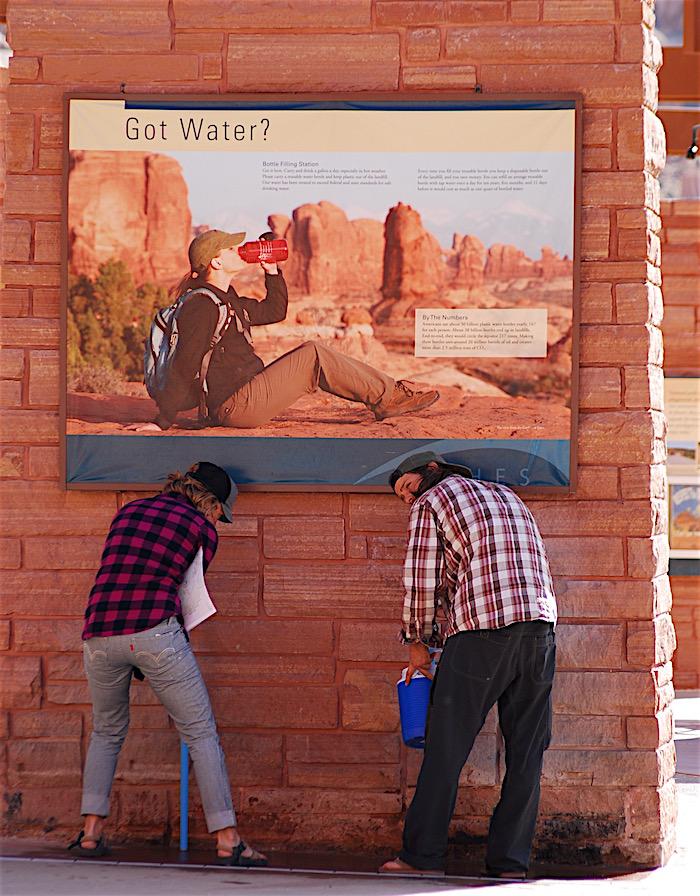
The National Park Service should work to reduce plastics pollution, not take a hands-off approach/Kurt Repanshek file
What message did the National Park Service send with its statement, after deciding to reverse a ban on the sale of disposable water bottles, that the move reflected "its commitment to providing a safe and world-class visitor experience..."?
That corporate lobbying carries the day?
That plastic pollution is not a global problem?
That it really isn't concerned about climate change?
That politics rule the day?
That its Green Parks Plan, which stresses sustainability and recycling, was little more than a slogan?
What the Park Service failed to mention when it said the reversal "comes after a review of the policy’s aims and impact in close consultation with Department of the Interior leadership" was that a new member of that leadership, Deputy Interior Secretary David Bernhardt, until joining the administration worked for a Washington, D.C., firm that lobbied for Nestle Water.
Plastic waste is an international problem. Not only do plastic bottles and other plastic waste take roughly 450 years to decompose -- for some bottles, it can be nearly three times as long -- but before that happens plastics pollute our oceans, where they are ingested by marinelife and seabirds, and litter landscapes.
Plastics in our oceans threaten marine life, human health and the viability of critical marine ecosystems. Marine life dies from plastic ingestion and entanglement, litter covers our coral reefs, and our food chain becomes increasingly contaminated.
Plastics never go away. Instead, they break down into smaller and smaller pieces, which act as magnets for polluting toxins. Eaten by fish, those chemical-laden microplastics work their way up the food chain and into our food supply. -- Oceana.org
Plastic waste also adversely impacts soils, according to Chemical and Engineering News.
According to the staff at Grand Canyon National Park, the ban:
- "(D)ecreases in plastics going to the landfill (although about 35% of the park’s waste stream is currently diverted to be recycled, it is estimated by the waste management staff that about 50% of what is taken to the landfill could also be recycled)"
- Helps reduce the amount of greenhouse gases generated by the manufacture of plastic bottles
- Reduces litter, of which plastic bottles are one of the top two sources along the rim trails
- Protects wildlife against plastic ingestion,
- And can even save visitors money as refilling stations are free.
"While the lifting of the ban is disappointing to hear, I believe that only a relatively few national parks (Bryce and Grand Canyon being two of them) actually took the step to ban sale of disposable water bottles in their parks," said Brent Reinke, a founder of Vapur, a reuseable water container. The company also has worked with parks to install water filling stations.
"So while there will likely be an impact on the effort to limit disposable water bottle sales (and accompanying waste associated with those bottles), I still believe there is and will be continued strong efforts to promote the use of reusable water bottles in our National Park System," he added.
At the Sierra Club, Public Lands Policy Director Athan Manuel said the Park Service's reversal "is clearly an industry-oriented move further emphasizing where this administration’s allegiances stand."
"Actions that roll back protections on our national parks and public lands only move our country backward -- putting the importance of local economies, wildlife and communities on the back burner. The reversal is but a symbol for this administration’s larger attacks on environmental safeguards and protection of public lands."
The point of the ban wasn't to entirely rid the landscape of plastics. That was evident in that it didn't also ban the sale of sodas and other drinks in plastic containers. But by providing refilling stations and mounting education campaigns around the problem of plastics and the value of reusable containers, the Park Service was taking a responsible stand to both educate visitors and reduce, if even just a little, the amount of litter.
In December 2011, then-Park Service Director Jon Jarvis, in a memorandum to his regional directors on the question of plastic water bottle sales, wrote that, "(S)ustainability is a signature effort for the National Park Service. We must be a visible exemplar of sustainability, so it is imperative that we move our sustainability program forward as an organization."
Sadly, with the reversal, the Park Service has moved its program backwards.



Comments
Just a message to those involved in the mass email sent out to NPS Superintendents on this issue yesterday-The vast majority of us do not have this issue (no sales outlets in parks)-While most of us have at least some empathy towards the plastic bottle issue, clogging our in boxes with what was almost a denial of service attack was counter productive. Just in case some of you watch this site.
"metal and glass containers are generally worse for the environment"?
No way, not a chance. Tell that to an albatross then their chicks eat nothing but plastic, or maybe you are not an ocean fish eater, because plastic is now being found in fishes and bivalves from the ocean. Generally, metal and glass break down relatively quickly or are from natural materials, but plastic breaks down to tiny pieces that we and others end up injesting, and the results are not good.